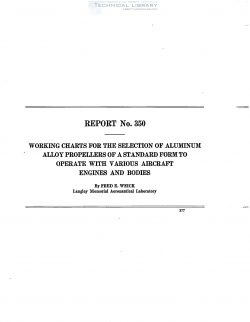naca-report-350

- Version
- 119 Downloads
- 974.23 KB File Size
- 1 File Count
- August 25, 2016 Create Date
- August 25, 2016 Last Updated
National Advisory Committee for Aeronautics, Report - Working Charts for the Selection of Aluminum Alloy Propellers of a Standard Form to Operate with Various Aircraft Engines and Bodies

Working charts are given for the conee—nie-nt selection of
aluminum alloy propellers of a stanahrdform, to operate
in connection with six difl'ere-nt engine-fitselage combina-
tions. The charts have been prepared from full-scale test
data obtained in the 20-foot propeller research tunnel of
the National Advisory Committee for Aeronautics. An
example is also mire-n showing the use of the charts.
Several aerodynamic tests on a standard form of
detachable blade metal propeller have been made in
the N. A. C. A. Propeller Research Tunnel at Langley
Field, Virginia. The tests have been made with
various odd pitch settings and with various engine-
iuselage combinations. In this report a set of faired
and cross-faired curves, with the blade angles at three-
iourths oi the tipradius reduced to even values, is
given for each propeller-engine-fnselage combination.
The curves may be used for the selection of geometri—
cally similar propellers for aircraft. The final adjusted
coefficients are also given in tabular form.
A standard form of metal propeller 9 feet in diameter .
was ‘used, having detachable aluminum alloy blades
which could be adjusted to any desired angle in a steel
split-type hub. A drawing showing the blade dimen-
sions (Navy design No. 4412) is given in Figure 1,
and the blade form is also given by the curves in
Figure 2. The propeller has standard propeller airfoil
sections based on the R. A. F. 6. The pitch is notable
in that it is very nearly uniform when the blades are
set to pitch ratios around .5, and increases toward the
tip for all higher pitch ratios. This is shown in
Figure 2, in which the pitch distribution is given for
several blade angle settings. (The settings are given
in terms of the blade angle at 75 per cent of the tip
radius, R, the various pitches having been obtained
by merely turning the blades in the hub.)
| File | Action |
|---|---|
| naca-report-350 Working Charts for the Selection of Aluminum Alloy Propellers of a Standard Form to Operate with Various Aircraft Engines and Bodies.pdf | Download |
Comment On This Post